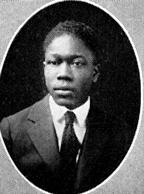Aaron Douglas Painter, Muralist
BFA in Art, 1922
Born in Kansas, Aaron Douglas received a B.F.A. in art from the University of Nebraska.
He taught in Kansas City schools for a few years and then began to study with Winold Reiss, an illustrator from Germany who encouraged him to look to African art for inspiration in his work. Douglas' use of African design and subject matter in his work brought him to the attention of William Edward Burghardt DuBois and Alain Locke, who were pressing for young African-American artists to express their African heritage and African-American folk culture in their art.
HARLEM RENAISSANCE
This was during the "Harlem Renaissance" or New Negro Movement, and Aaron Douglas became a leading visual artist during this time. In fact, he was called the "Dean of African-American painters" at a time when DuBois and others were trying desperately to convince painter Henry O. Tanner to return from Europe and establish a school of Negro painting.
Other painters active during this time included:
• Palmer Hayden
• Archibald Motley
• William H. Johnson
• Malvin Grey Johnson
• Laura Wheeler Waring
Douglas' work was published regularly in The Crisis. He also illustrated for Opportunity and Vanity Fair magazines. His most famous illustrations were for James Weldon Johnson's book of poetic sermons, God's Trombones. Alain Locke called him a "pioneering Africanist" and used his illustrations in his famous anthology, The New Negro, published in 1925 in which his classic essay "The Legacy of the Ancestral Arts" appeared.
WPA COMMISSION AND FISK UNIVERSITY
In 1934, Douglas was commissioned, under the sponsorship of the WPA, to paint a series of murals for the 135th Street Branch of the New York Public Library. The library murals attempt to give a symbolic representation to certain aspects of Negro life. Aaron Douglas' style, flat with hard edges and repetitive designs, was heavily influenced by African sculptures, jazz music, dance and geometric forms.
Douglas joined the faculty of Fisk University in 1937 and stayed there until his retirement in 1966. His artistic insight is a lasting influence and a testament to the themes of African heritage and racial pride.
"Aaron Douglas (1898-1979)." Harlem 1900-1940. No Date. New York Public Library. 24 Nov. 2008 ‹http://www.nypl.org/research/sc/Harlem/text/adouglas.html›.
